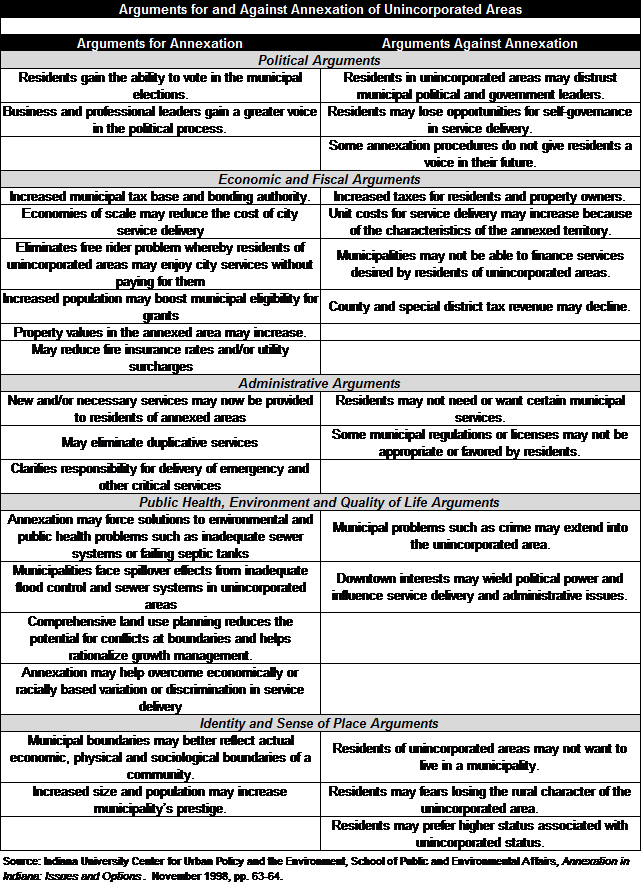August 22, 2014
Unincorporated areas lie outside municipal boundaries. The residents and businesses located in these areas are usually provided municipal services such as police protection and building code enforcement by county government or special districts. Because unincorporated areas may be scattered throughout a county’s territory, the provision of these services by counties has been inefficient and costly. Annexation of unincorporated areas to neighboring municipalities is often proposed as a solution to this problem. Cook County is currently engaged in a multi-year exploration of ways to encourage annexation of unincorporated areas to neighboring municipalities to reduce budgetary pressures and improve the efficiency of municipal service delivery in these areas.
This blogpost discusses arguments for and against annexation of unincorporated areas.
Annexation is the extension of municipal boundaries into adjacent unincorporated areas and the corresponding expansion of city services to those newly incorporated areas. In Illinois, municipal governments have the authority to determine and expand their boundaries, subject to the provisions of the Illinois Municipal Code (65 ILCS 5/ Illinois Municipal Code).
In other states, that power has been given to the state government or regional authorities.
Unincorporated Areas in Cook County
In Cook County, approximately 15% of the land area is unincorporated with dozens of small unincorporated areas scattered throughout the County. County taxpayers who reside in municipalities effectively pay a subsidy to cover municipal services for residents of unincorporated areas, even as they pay taxes for their own municipal services. Providing services to unincorporated areas is also expensive. In FY2010, the County’s cost of law enforcement, building and zoning and animal control was approximately $54.7 million or $501 per resident of the unincorporated areas (FY2010 Cook County Appropriation Bill). These expenses reduce the resources available to fulfill the County’s core responsibilities – healthcare and criminal justice.
Cook County Board President Toni Preckwinkle convened a task force in November 2011 to examine the costs and services provided to unincorporated Cook County. The Task Force has spent the past two years evaluating opportunities to share costs in a fairer fashion for both unincorporated and incorporated residents and to improve service delivery to residents of unincorporated areas. In April 2012, the Task Force released preliminary recommendations and found that the County’s long-term goal should be the elimination of all unincorporated areas such that every resident of Cook County is also a resident of a municipality. Aware of the challenges involved with this goal, the Task Force also recommended additional study to evaluate service needs of the unincorporated areas and to identify existing barriers to incorporation.
The Civic Federation is currently undertaking research to describe the unincorporated geographical areas in Cook County and to identify barriers to incorporation by surrounding municipalities for these areas. The research will be published in two reports, the first in the fall of 2014 and the second one year later.
Arguments for and Against Annexation
To understand why areas may remain unincorporated, it is necessary to explore the reasons for and against incorporation.
Annexation of unincorporated areas to a municipality can be controversial. There are a number of political, economic, quality of life and identity arguments made in support of and opposition to annexation. These arguments were concisely summarized in a report by the Center for Urban Policy and the Environment at Indiana University’s School of Public and Environmental Affairs in a study of Indiana’s annexation laws. A summary and adaptation of the highlights are presented in the exhibit below[1].

[1] Indiana University Center for Urban Policy and the Environment, School of Public and Environmental Affairs, Annexation in Indiana: Issues and Options. November 1998, pp. 63-64.

